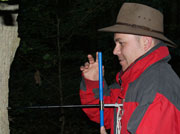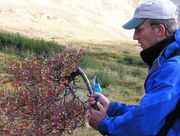
WP3: Tree-ring data
Suitable living trees of 200-300 years of age are widespread in the research area and by matching the patterns of ring widths in living trees with those in archaeological wood remains (provided by associated partner German Archaeological Institute), old buildings, standing dead wood, or logs dragged from lakes it we will to produce long, well replicated annually resolved chronologies extending back to 3000BP. Usually all that was recorded until today is the width of the tree-rings. The virtual institute ICLEA will take full advantage of the potential of tree ring chronologies as physical archives and apply a truly multi-proxy approach to extracting the rich climate and environmental information that they contain.
The major task of WP 3 is to extract high quality proxy data from a regional network of tree sites and species (i.e. oak, beech, alder and pine) distributed across northeastern Germany and northern Poland. Assisted by the associated partners, Johann Heinrich von Thünen Institute, German Archaeological Institute, National Park Müritz and Biosphäre Reserve Service Schorfheide-Chorin the two dendro-teams of GeoForschungszentrum Potsdam and Greifswald University comprise the necessary local knowledge, scientific expertise, laboratory and analytical facilities to produce complete chronologies from a network of sites. Annually-resolved and precisely dated chronologies will include: annual ring width, relative wood density, wood cell structure, the stable isotopic ratios of carbon and oxygen, as well as multi-element concentrations from µ-XRF-scanning. Each proxy carries a different environmental signal, and by combining them, using both statistical and mechanistic methods, we will produce the best set of tree-ring based reconstructions that has ever been possible for the study region. Response functions will be obtained by means of an in-depth study of stable isotopes and wood anatomy in tree growth rings in various ways. The project will concentrate on using tree-ring derived data including plant-derived process data, that is, from stable isotopes, cell structure and radial increment. The complexities of the isotope fractionation processes from photosynthesis in the leaf to cellulose formation in the tree-ring will be quantified by in-situ plant ecophysiological experiments. We are confident of providing precisely dated, statistically verifiable climate reconstructions with temporal resolution that are seasonal, annual and decadal as required by the objectives of the program. The results will allow verification and construction of more accurate climate models.


